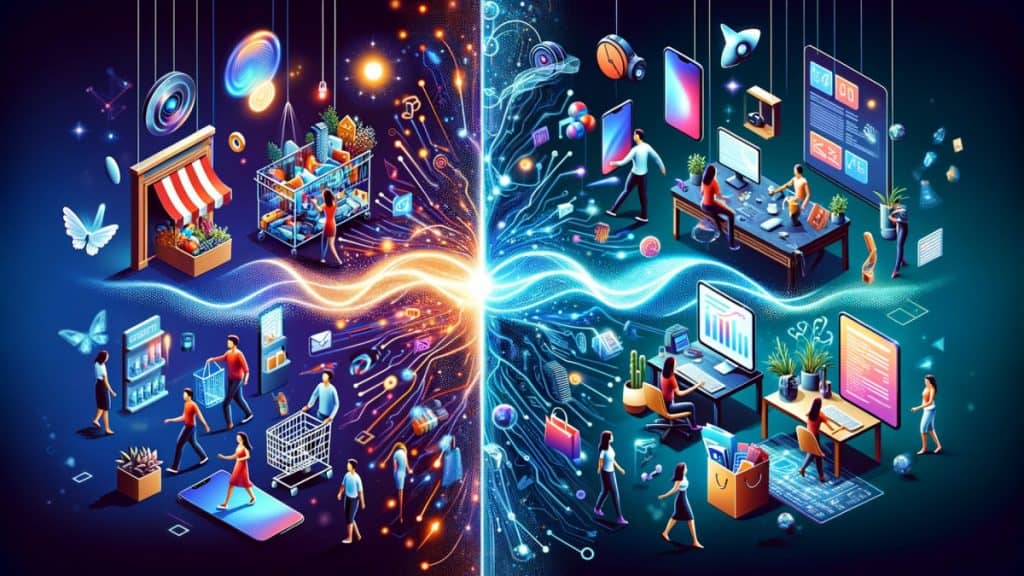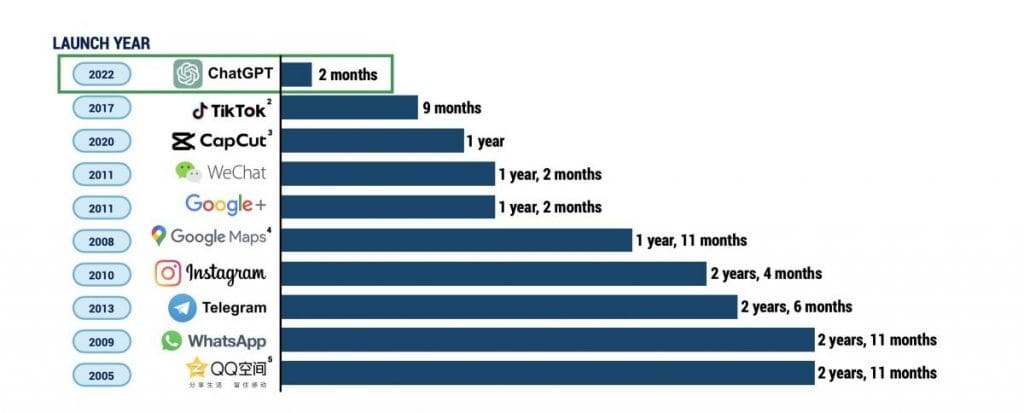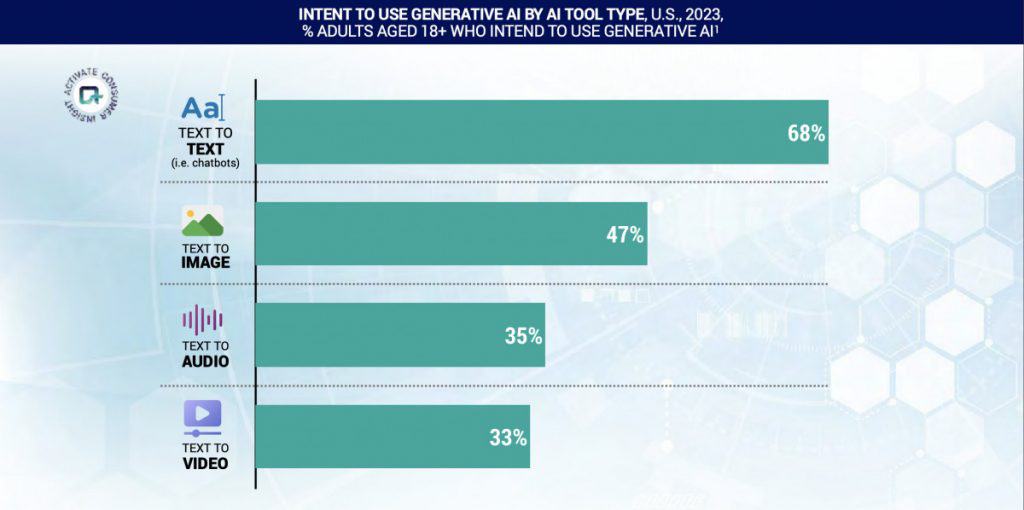


Despite a recent decline in web traffic, ChatGPT has seen its total monthly visits double from April to August 2023, indicating a significant shift in user preference towards mobile platforms.
This trend highlights the adaptability and growing reliance on generative AI tools like ChatGPT, Google Bard, and Bing Chat, which have all witnessed substantial usage within a year of their launch. Likewise, Adobe’s Firefly has also shown rapid growth in just a few months.

ChatGPT‘s Impact on Consumer and Work Habits
Generative AI is set to massively change consumer behaviors and boost productivity across various domains, including media and work.
With its rapid adoption rate—reaching 100 million monthly active users (MAUs) in just two months—ChatGPT exemplifies this transformative impact. Over half of those aware of generative AI tools intend to use them in the future, particularly drawn to text-to-text and text-to-image applications.
Key Components of the Generative AI Ecosystem

The report shows that the generative AI landscape comprises of four fundamental components: models, data, compute, and interfaces & software tools.
Different companies are expected to benefit from each aspect, and the playing field extends beyond major tech players. The rise of open-source AI models is opening doors for smaller entrants, diversifying the market.
Currently, over 10 million U.S. adults start their web searches with generative AI, a number projected to grow to 90 million by 2027. This trend promises to reshape the largest technology businesses. In the workplace, generative AI is especially popular among younger and higher-income employees.
About 16% currently use generative AI in their jobs, with 21% planning to use it in the next 12 months. Knowledge-based and creative functions, such as IT and marketing, are leading in AI use with high expected future growth.
Investment and Corporate Integration of Generative AI

Generative AI-related ventures have experienced nearly 200% growth year-over-year as of August 2023. Investments primarily focus on broad use case platforms, software infrastructure and B2B applications, making up over 95% of total investments.
Companies looking to leverage AI benefits do not need to develop in-house solutions, as major AI companies are creating plug-ins and integrations for a broader ecosystem.
This surge in generative AI usage and investment reflects a significant shift in how both consumers and businesses interact with technology, signaling an era where AI becomes an integral part of daily life and work processes.
Disclaimer
Any data, text, or other content on this page is provided as general market information and not as investment advice. Past performance is not necessarily an indicator of future results.
![]()
![]()
The Trust Project is a worldwide group of news organizations working to establish transparency standards.
Nik is an accomplished analyst and writer at Metaverse Post, specializing in delivering cutting-edge insights into the fast-paced world of technology, with a particular emphasis on AI/ML, XR, VR, on-chain analytics, and blockchain development. His articles engage and inform a diverse audience, helping them stay ahead of the technological curve. Possessing a Master’s degree in Economics and Management, Nik has a solid grasp of the nuances of the business world and its intersection with emergent technologies.

Nik Asti

Nik is an accomplished analyst and writer at Metaverse Post, specializing in delivering cutting-edge insights into the fast-paced world of technology, with a particular emphasis on AI/ML, XR, VR, on-chain analytics, and blockchain development. His articles engage and inform a diverse audience, helping them stay ahead of the technological curve. Possessing a Master’s degree in Economics and Management, Nik has a solid grasp of the nuances of the business world and its intersection with emergent technologies.
Read More: mpost.io











 Bitcoin
Bitcoin  Ethereum
Ethereum  Tether
Tether  XRP
XRP  Solana
Solana  USDC
USDC  Dogecoin
Dogecoin  TRON
TRON  Cardano
Cardano  Lido Staked Ether
Lido Staked Ether  Wrapped Bitcoin
Wrapped Bitcoin  Hyperliquid
Hyperliquid  Sui
Sui  Wrapped stETH
Wrapped stETH  Chainlink
Chainlink  Avalanche
Avalanche  Stellar
Stellar  Bitcoin Cash
Bitcoin Cash  Toncoin
Toncoin  LEO Token
LEO Token  Shiba Inu
Shiba Inu  Hedera
Hedera  WETH
WETH  USDS
USDS  Litecoin
Litecoin  Wrapped eETH
Wrapped eETH  Monero
Monero  Polkadot
Polkadot  Binance Bridged USDT (BNB Smart Chain)
Binance Bridged USDT (BNB Smart Chain)  Ethena USDe
Ethena USDe  Bitget Token
Bitget Token  Pepe
Pepe  Pi Network
Pi Network  Coinbase Wrapped BTC
Coinbase Wrapped BTC  WhiteBIT Coin
WhiteBIT Coin  Aave
Aave  Uniswap
Uniswap  Bittensor
Bittensor  Dai
Dai  Ethena Staked USDe
Ethena Staked USDe  Aptos
Aptos  NEAR Protocol
NEAR Protocol  Cronos
Cronos  OKB
OKB  Jito Staked SOL
Jito Staked SOL  BlackRock USD Institutional Digital Liquidity Fund
BlackRock USD Institutional Digital Liquidity Fund  Internet Computer
Internet Computer  Ondo
Ondo  Ethereum Classic
Ethereum Classic